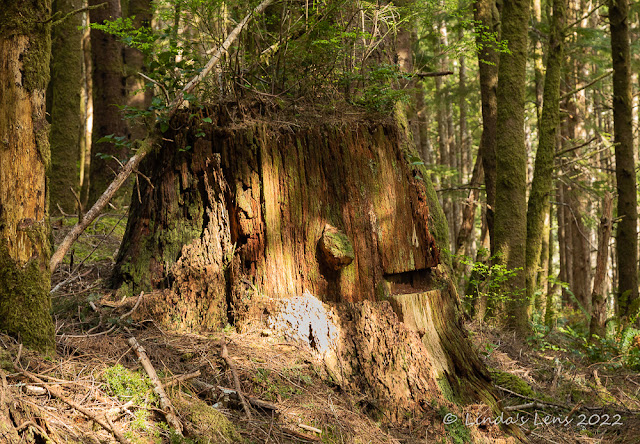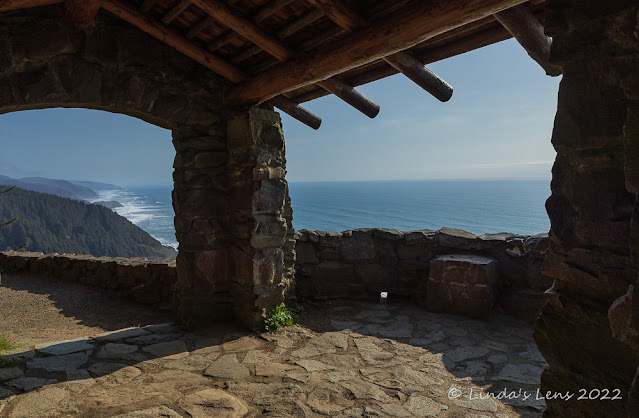Yes, I'm still alive!
I know, I know, it's been way too long since my last post. This time, thankfully, my hiatus wasn't due to a medical issue. In late May-early June I took a fantastic two-week vacation to South Dakota with a side trip to Minneapolis for a wedding. It was a whirlwind of family, two birthdays and a wedding, critter photography, and lots of driving (I logged over 4,000 miles on my car!) Now that I'm finally home, it's time to get this blog caught up.
 |
| Beautiful coastline at Yachats |
So let's start with a past coastal trip. In late April I journeyed south and west to Cape Perpetua, one of my favorite places on the Oregon coast. My hope was not only to capture some good wave action and sunset photos, but also to explore a couple "new-to-me" trails in the vicinity.
 |
| Sea pink |
As with previous trips, I scored a yurt at Carl Washburne State park for two nights. Since I couldn't check in until 1 pm, I killed time exploring the nearby cute seaside town of Yachats (pronounced "yah-hots"). There were several scenic beaches with parking areas and I chose the one closest to the main drag. A bright pink flower called "Sea pink" (also known as "Sea thrift") was blooming here, which made for a colorful compliment to my seascape images.
 |
| Wildflowers at the trailhead |
After checking into my yurt, I grabbed camera and backpack before heading out to tackle the first of two planned hikes, the Amanda Trail. This trail can be started at either the north trailhead, near the south end of Yachats, or at the south terminus near the stone shelter on top of Cape Perpetua. Between these two endpoints, this trail first follows Highway 101 out of Yachats before finally ducking into the woods. The trail climbs to an amazing suspension bridge and an amphitheater with a statue honoring Amanda, the trail's namesake (more on this in the next few paragraphs.) Then the trail continues steeply uphill until it reaches the southern trailhead on top of Cape Perpetua.
 |
| Lush coastal forest |
Since I wasn't keen on walking next to a busy highway, I planned to skip this portion of the trail and start my hike on top of Cape Perpetua. I decided to travel only as far as the Amanda statue before turning around and retracing my steps. Seeing the statue of the trail's namesake was why I'd chosen to tackle this particular hike.
 |
| Yellow violets |
After locating the trailhead parking, a pull-out on the road to Cape Perpetua's stone shelter, I followed the trail downhill. At a fork in the path, I chose the wrong way (heading up to the shelter instead of down towards the statue) so had to backtrack about a quarter mile once I discovered my mistake. But once headed in the correct direction I ambled through a typical coastal forest full of ferns, mossy trees, and spring wildflowers. As all coastal forests are, this one was quite lovely.
 |
| Pink-striped wildflowers |
I climbed uphill for a ways, which totally surprised me. Reading the hike description from the Oregon Hikers website I was under the impression the trail dropped from the trailhead all the way to the statue. But no worries - I eventually hit the trail's high point and then it was all downhill from there!
 |
| More forest scenes |
At one point along the trail I began to notice a skunky odor. I thought this unpleasant smell resembled marijuana, and grumbled to myself about some fellow hiker having a toke in the woods and leaving his stinky smoke behind.
 |
| Stinky skunk cabbage bog |
Then I came to a boggy spot where the trail crossed a small stream. Skunk cabbage plants were all over the place. It was then that I realized these plants were the source of the unpleasant odor I'd been smelling! Skunk cabbage is notorious for it's rotten stench.
 |
| The smelly culprit |
Skunk cabbage may reek, but it's yellow flowers are pretty. While bent over taking photos of the blooms, two young ladies caught up to me. When I pointed out the source of the bad odor, both women commented that they'd also thought the stench was due to marijuana!
 |
| This trillium has seen better days |
Downward I continued, past the stinky bog, spotting lots of trillium flowers and humungous old stumps from bygone logging days. Keeping a sharp eye out for the Amanda statue I assumed I was getting close. But around every bend there were just more trees. I didn't miss it, did I?
 |
| Amazing suspension bridge |
Finally the trail opened up into a clearing. A drainage was below. An impressive suspension bridge spanned it's channel. I'd read that a winter storm in 2015 caused a debris slide that wiped out the old bridge and this was the replacement. What a grand replacement it was!
 |
| The bridge provides access to the Amanda statue |
I love crossing suspension bridges. This one swayed with my movements, which I thought was fun. Looking across to the opposite side, I noticed rows of crude benches. Then I saw the statue front and center. This was the place! I'd finally arrived!
 |
| Finally - the Amanda statue! |
The entire area was well done. A graded gravel path with steps led visitors to the site. An amphitheater of wooden benches had been constructed facing the statue. Two interpretive signs explained the reason for the memorial. Amanda DeCuys was was an old, blind native woman who lived with a white settler near Coos Bay in 1864. She produced a daughter with the settler, but they never married.
 |
| A peaceful place |
An 1855 treaty with the Coastal tribes of Oregon established a Coast Indian Reservation. Twenty-seven different native tribes were crowded together and expected not only to coexist, but to also take up agriculture and adopt the white man's ways. Not surprisingly, many Indians didn't stick around. They drifted back to their ancestral hunting grounds or sought paid employment outside of the reservation.
 |
| Amanda is adorned with beads of all varieties |
Government Indian agents were not happy with the mass exodus of natives leaving the reservation, and in the spring of 1864 devised a plan to round up the escapees. In Coos Bay the army captured 46 Indians, mostly women who had been acting as wives to local loggers. One corporal tasked with capturing the runaway Indians recounted in his diary seizing an "old and blind" native woman named Amanda DeCuys who had been living with a white farmer and had a young daughter by him. Despite being a mother, Amanda was ripped away from her family and forced to march with a group of other natives back to the reservation.
 |
| Colored rocks have been left at her base |
It was an awful journey. Many of the woman and children in the party fell in exhaustion. On the final day the group had to negotiate the sharp basalt of Cape Perpetua, where Amanda, being blind and unable to see where she was walking, tore her feet horribly on the rocks. Once the party arrived at the reservation, no further mention was made of Amanda's fate.
 |
| Beads and dreamcatchers dangle from nearby trees |
Amanda's Trail was the brainchild of a Minnesota couple who purchased land near Yachats along Highway 101. It was their desire to establish a portion of the Oregon Coast trail through this property. But government wheels move slowly, and it took over 10 years for the project to be completed. Learning the sad history of past forced relocations from local native tribes it was decided to name the trail after Amanda. In 2009 a small statue was placed in a fern-filled grotto near Amanda Creek, and several representatives of local native tribes attended the formal dedication. The original statue was buried by the same 2015 debris slide that wiped out the first bridge. The trail was reconstructed and a new statue placed where it stands today.
 |
| Old growth stump with notch |
I found the Amanda statue adorned with various beaded necklaces and other offerings. A pile of colorful rocks sat at her base. Dreamcatchers hung from a nearby tree. It was a quiet, serene place - a fitting tribute to this brave native woman who was cruelly wronged. Some people want to ignore the dark sides of history, but I think it is good to bring these terrible events to light. As a society we need to learn from past injustices so that they may never be repeated.
 |
| Cape Perpetua stone shelter |
After having the statue area to myself for an entire half hour, the arrival of another party broke the spell and I decided it was time to head back. I now had a mostly uphill trek to look forward to!
 |
| Fantastic views from the shelter |
For some reason the return trip on most hikes always seems quicker. This trail was no exception and before I knew it the trailhead and my waiting car came into view.
 |
| The Pacific Ocean view |
I drove the final quarter mile to the parking area on top of Cape Perpetua. A short trail led me to the stone shelter sited on the cape's very apex, boasting awesome views up and down the Oregon Coast. Construction of this stone shelter was a CCC (Civilian Conservation Corp) project from the 1930's.
 |
| Spouting horn below Cape Perpetua |
Later that evening I returned to the tidepools below Cape Perpetua in hopes of catching a sunset over this unique, rocky coastline. It happened to be high tide, and the huge waves crashing into the shoreline provided much entertainment. One of the formations, called "Spouting Horn" was especially fun to watch. When large waves moved up a narrow, rocky chasm, they forced water through a hole in the basalt, causing a vertical column of water to shoot high into the sky.
 |
| Wave action at high tide |
That evening's sunset was a dud. However, while waiting for nightfall I amused myself by taking images of the huge waves crashing below. I had another full day of hiking and photography planned for tomorrow, which I'll cover in my next post. Stay tuned!

...the Amanda statue is a fabulous destination!
ReplyDeleteBeautiful coastline with some stunning photos. The story of Amanda is very sad & I feel it is very touching that she is remembered in such a beautiful way
ReplyDeleteAmanda's story is very sad. I honestly hope we can learn something from history. Sadly, the reality seems the opposite.
ReplyDeleteFascinating and tragic story of Amanda. Would you believe we saw sea thrift on St. Kilda's Isle off the NW coast of Scotland!
ReplyDeleteSea Pink is also relatively common around the British coastline. Amanda's statue has a certain rugged beauty which is added to by the colourful beads and stones. We've perhaps reduced some of the more obvious manifestations of cruelty in our part of the world, but many minorities are still subjected to psychological and financial abuse, which we may one day come to regret.
ReplyDeleteWow, what a fabulous place to visit and photograph!
ReplyDeleteThanks for the Travelogue. I never knew about the suspension bridge and the Amanda statue. It can be a destination for us on a future trip to Oregon.
ReplyDeleteWhat a wonderful read, especially your sensitive writing of Amanda's sad story.
ReplyDeleteInteresting story about Amanda. :)
ReplyDeleteI’m glad they rebuilt the trail and replaced the statue. Love the beads!
ReplyDelete